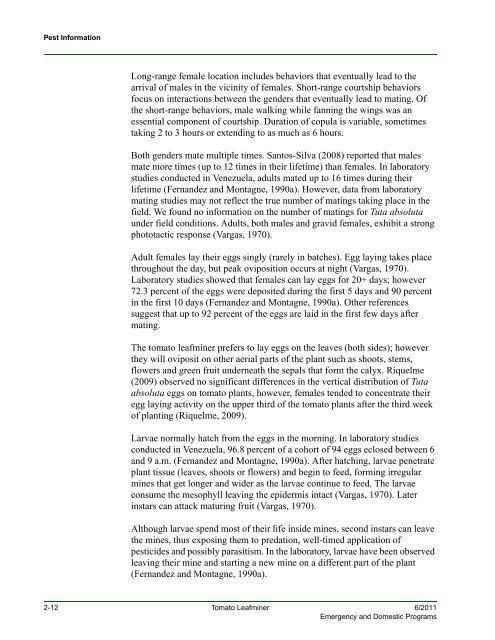1 - Phytosanitary Resources
1 - Phytosanitary Resources
1 - Phytosanitary Resources
You also want an ePaper? Increase the reach of your titles
YUMPU automatically turns print PDFs into web optimized ePapers that Google loves.
Pest Information<br />
Long-range female location includes behaviors that eventually lead to the<br />
arrival of males in the vicinity of females. Short-range courtship behaviors<br />
focus on interactions between the genders that eventually lead to mating. Of<br />
the short-range behaviors, male walking while fanning the wings was an<br />
essential component of courtship. Duration of copula is variable, sometimes<br />
taking 2 to 3 hours or extending to as much as 6 hours.<br />
Both genders mate multiple times. Santos-Silva (2008) reported that males<br />
mate more times (up to 12 times in their lifetime) than females. In laboratory<br />
studies conducted in Venezuela, adults mated up to 16 times during their<br />
lifetime (Fernandez and Montagne, 1990a). However, data from laboratory<br />
mating studies may not reflect the true number of matings taking place in the<br />
field. We found no information on the number of matings for Tuta absoluta<br />
under field conditions. Adults, both males and gravid females, exhibit a strong<br />
phototactic response (Vargas, 1970).<br />
Adult females lay their eggs singly (rarely in batches). Egg laying takes place<br />
throughout the day, but peak oviposition occurs at night (Vargas, 1970).<br />
Laboratory studies showed that females can lay eggs for 20+ days; however<br />
72.3 percent of the eggs were deposited during the first 5 days and 90 percent<br />
in the first 10 days (Fernandez and Montagne, 1990a). Other references<br />
suggest that up to 92 percent of the eggs are laid in the first few days after<br />
mating.<br />
The tomato leafminer prefers to lay eggs on the leaves (both sides); however<br />
they will oviposit on other aerial parts of the plant such as shoots, stems,<br />
flowers and green fruit underneath the sepals that form the calyx. Riquelme<br />
(2009) observed no significant differences in the vertical distribution of Tuta<br />
absoluta eggs on tomato plants, however, females tended to concentrate their<br />
egg laying activity on the upper third of the tomato plants after the third week<br />
of planting (Riquelme, 2009).<br />
Larvae normally hatch from the eggs in the morning. In laboratory studies<br />
conducted in Venezuela, 96.8 percent of a cohort of 94 eggs eclosed between 6<br />
and 9 a.m. (Fernandez and Montagne, 1990a). After hatching, larvae penetrate<br />
plant tissue (leaves, shoots or flowers) and begin to feed, forming irregular<br />
mines that get longer and wider as the larvae continue to feed. The larvae<br />
consume the mesophyll leaving the epidermis intact (Vargas, 1970). Later<br />
instars can attack maturing fruit (Vargas, 1970).<br />
Although larvae spend most of their life inside mines, second instars can leave<br />
the mines, thus exposing them to predation, well-timed application of<br />
pesticides and possibly parasitism. In the laboratory, larvae have been observed<br />
leaving their mine and starting a new mine on a different part of the plant<br />
(Fernandez and Montagne, 1990a).<br />
2-12 Tomato Leafminer 6/2011<br />
Emergency and Domestic Programs













